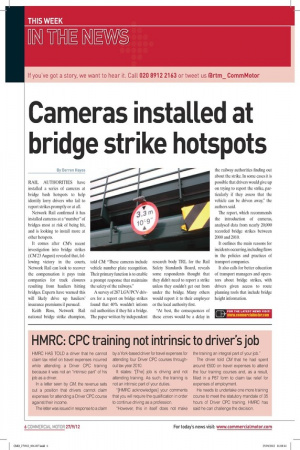Cameras installed at bridge strike hotspots
Page 4

If you've noticed an error in this article please click here to report it so we can fix it.
By Derren Hayes
RAIL AUTHORITIES have installed a series of cameras at bridge bash hotspots to help identify lorry drivers who fail to report strikes promptly or at all.
Network Rail conirmed it has installed cameras at a “number” of bridges most at risk of being hit, and is looking to install more at other hotspots.
It comes after CM’s recent investigation into bridge strikes (CM 23 August) revealed that, following victory in the courts, Network Rail can look to recover the compensation it pays train companies for track closures resulting from hauliers hitting bridges. Experts have warned this will likely drive up hauliers’ insurance premiums if pursued.
Keith Ross, Network Rail national bridge strike champion, told CM: “These cameras include vehicle number plate recognition. Their primary function is to enable a prompt response that maintains the safety of the railways.” A survey of 287 LGV/PCV drivers for a report on bridge strikes found that 40% wouldn’t inform rail authorities if they hit a bridge. The paper written by independent research body TRL for the Rail Safety Standards Board, reveals some respondents thought that they didn’t need to report a strike unless they couldn’t get out from under the bridge. Many others would report it to their employer or the local authority irst.
“At best, the consequences of these errors would be a delay in the railway authorities inding out about the strike. In some cases it is possible that drivers would give up on trying to report the strike, particularly if they assess that the vehicle can be driven away,” the authors said.
The report, which recommends the introduction of cameras, analysed data from nearly 20,000 recorded bridge strikes between 2000 and 2010.
It outlines the main reasons for incidents occurring, including laws in the policies and practices of transport companies.
It also calls for better education of transport managers and operators about bridge strikes, with drivers given access to route planning tools that include bridge height information.










































